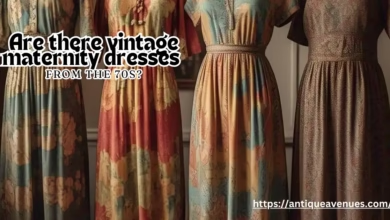Do vintage clothes contain lead?

The vintage clothing is commended for its unique style, fine craftsmanship, and sustainable production methods. When vintage clothing gains appeal, so does its safety, specifically in light of risky elements like lead. The metal lead, a harmful heavy metal, was widely used in the production of textiles, paint, dye, and decorations during the 19th and 20th centuries. This tutorial examines whether contribute is present in vintage clothing, the origins and consequences, lead methods for testing, and safe handling and buying procedures.
Historical Use of Lead in Clothing Production

Lead-Based Dyes and Paints
The full spectrum of the problems presented by lead was realized; manufacturing companies used lead-based dyes to create vibrant, durable colors in textiles. These colors were most frequently used in apparel produced before the 1970s. Due to their durability and bright hues, lead-based paints have been extensively used for hand-painted designs on old scarves, aprons, and children’s clothes. These paints may deteriorate, flake, and become powdery, increasing the risk of lead exposure through skin contact and breath.
Metal Components
It was commonly discovered in metal parts of clothes, such as buttons, zippers, hooks, buckles, and decorative trims. The precious stones, sequins sewn onto garments, and antique brass and pewter embellishments may contain large quantities of lead, especially in goods limiting their use. These steel parts could corrode and decompose, generating lead dust and other particles.
Weighted Silk
“The weighted average silk” is a lesser-known, yet important source of lead in past apparel. It was made denser and more copious in the late 19th and early 20th millennia through the use of metallic salts, including lead acetate. The silk garments seem more luxurious, this process hastened the degradation of the fabric and put the health of anyone handling or wearing them at risk.
Common Sources of Lead in Vintage Clothing
Painted or Printed Fabrics
Many vintage apparel, particularly uniforms, aprons, and young people’s apparel, contain painted and printed designs. If these were created prior to legislation barring lead in common products, they may contain dangerously high levels of lead. The flaking and decaying paint of these fabrics presents direct exposure, particularly through skin contact and dust inhalation.
Imported Garments
The amount of lead in vintage clothing imported from countries with traditionally inadequate safety regulations may be higher. The possibility that mass-manufactured apparel from specific times and places contained potentially dangerous materials increased because it was more unregulated than clothing produced in the US and Europe.
Secondhand Contamination
The keeping alongside other lead-containing objects, such as outdated storage boxes, painted surfaces, and furniture, even if it wasn’t made with lead. A person handling and using the garments may be at primary risk of exposure to lead dust that settles on the fabric.
“Greenwashed” Vintage Lines
The metal is also present in the trims and embellishments used by modern “vintage-inspired” and repurposed clothing brands, such as the Urban Renewal line from Urban Outfitters. This demonstrates that even recently promoted “green” and “vintage” products may contain lead, especially when they are made from recycled materials.
Health Risks of Lead Exposure
Routes of Exposure
Lead can enter the body through several routes:
- Skin Absorption: Direct contact with lead-contaminated fabrics, especially if the skin is broken or if sweat increases absorption.
- Inhalation: Breathing in lead dust from deteriorating paints, trims, or metal components.
- Ingestion: Hand-to-mouth transfer, particularly dangerous for children who may put clothing or their hands in their mouths after touching contaminated garments.
Vulnerable Populations
The children are especially vulnerable to lead poisoning, which can lead to delayed development, behavioral problems, and learning challenges. The child women are especially at high risk, as exposure to lead can impact fetal development and increase the likelihood of an early birth. A person who frequently and continuously comes into contact with clothing that contains lead risks suffering negative health effects.
Long-Term Effects
A sustained exposure to lead can lead to behavioral problems, memory loss, diminished IQ, and irreversible brain damage. The reproductive systems, the circulatory system, and kidneys. There is currently no safe limit for lead exposure, and even extremely low levels can be detrimental.
Testing Vintage Clothing for Lead
Home Testing Kits
The hardware stores sell do-it-yourself lead test kits, including D-Lead and LeadCheck, which can detect surface lead rapidly. These swab-based kits are helpful for testing trims, buttons, and painted surfaces. The results can sometimes be challenging to decode, and they may not recognize lead embedded in threads beneath the surface.
Professional Testing
The specialist testing is advised for more precise results. Lead content in textiles and metal components can be found using X-ray fluorescence (XRF) analyzers without causing any harm to the clothing. A complete findings on the presence and amount of lead can be obtained through laboratory testing, which involves sending samples of cloth and accessories for assessment.
Interpreting Results
Most particularly for children, there is no known safe dose of lead exposure. It is advised to avoid using the garment if any lead is found, especially if the wearer is vulnerable. In the years to come, even minute amounts can accumulate in the body and be harmful.
Prevention and Safety Measures

Safe Handling Practices
A pair of gloves while working with old clothing that may contain lead, and think about donning a mask to prevent dust inhalation. In an ideal world, keep these items in closed bags and store them apart from other clothes to avoid cross-contamination. Do not handle and wear such clothing if you are expectant and have small children.
Cleaning Guidelines
Washing may remove some surface dust, but will not eliminate embedded lead in fibers or paints. The real world, washing can transfer pollutants to other objects. Professional cleaning firms aware of the dangers of lead in textiles might offer safer cleaning solutions, but total decontamination is frequently impossible.
When to Avoid Vintage Clothing
The vintage clothing with heavy metal accents, flaking paint, painted graphics, and unclear provenance should not be worn and purchased. Most particularly for youngsters and expectant mothers, it is best to err on the side of prudence and avoid wearing a garment if its safety cannot be confirmed.
Legal and Regulatory Context
Historical Regulations
The lead-based paints were outlawed in homes across the United States in 1978, but clothing was exempt. The metal limits in consumer goods, such as children’s apparel and accessories, have been strengthened over time by US and EU laws (such as the Consumer Product Safety Improvement Act and CPSIA). These rules, however, do not apply retrospectively to used and vintage goods.
Enforcement Gaps
The fashionable, vintage, and used clothing is frequently exempt from the most recent safety requirements. Many goods found in secondhand stores, antique shops, and internet marketplaces could still have excessive lead content. Global imports can also bypass safety checks, allowing contaminated garments from unregulated regions to enter the market.
Case Studies and Real-World Examples
Ross and Burlington Findings
A quarter of tested products (belts, purses) from bargain stores like Ross and Burlington had lead, sometimes at levels as high as 1.7%, according to a 2022 Center for Environmental Health (CEH) research. These results reveal that lead is still present in both contemporary and vintage “vintage-style” goods.
Urban Outfitters’ Urban Renewal Line
Investigations into Urban Outfitters’ Urban Renewal line revealed lead and cadmium in up to 64% of tested “upcycled” jewelry and accessories. This demonstrates that even new products marketed as sustainable or vintage-inspired can pose lead exposure risks.
Weighted Silk Degradation
The historians and conservators have reported incidents when silk gowns from the late 19th century weighted with lead quickly deteriorated and presented health hazards to people who handled them. This demonstrates how seemingly safe vintage clothing can have hidden risks.
Conclusion
The risk of lead in outdated clothing is significant and often underestimated. These clothes are fashionable and nostalgic, but they can contribute to one’s health, particularly for collectors, pregnant women, and children. The vintage fashion to be worn safely, testing, prudence, and careful buying are necessary.





One Comment